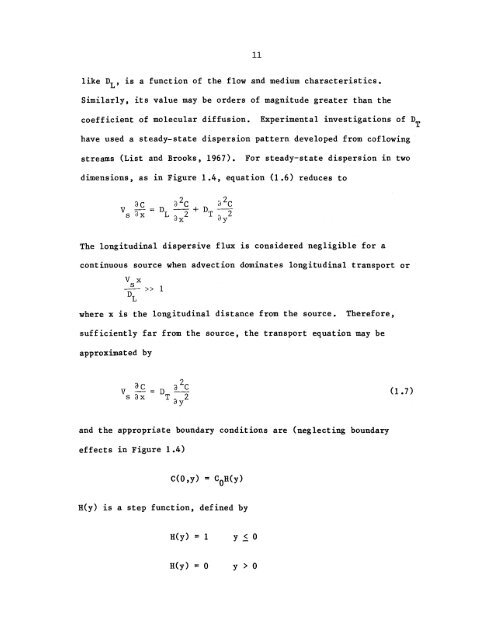longitudinal dispersion in nonuniform isotropic porous media
longitudinal dispersion in nonuniform isotropic porous media
longitudinal dispersion in nonuniform isotropic porous media
You also want an ePaper? Increase the reach of your titles
YUMPU automatically turns print PDFs into web optimized ePapers that Google loves.
like D L , is a function of the flow and medium characteristics.<br />
Similarly, its value may be orders of magnitude greater than the<br />
11<br />
coefficient of molecular diffusion. Experimental <strong>in</strong>vestigations of DT<br />
have used a steady-state <strong>dispersion</strong> pattern developed from coflow<strong>in</strong>g<br />
streams (List and Brooks, 1967). For steady-state <strong>dispersion</strong> <strong>in</strong> two<br />
dimensions, as <strong>in</strong> Figure 1.4, equation (1.6) reduces to<br />
The <strong>longitud<strong>in</strong>al</strong> dispersive flux is considered negligible for a<br />
cont<strong>in</strong>uous source when advection dom<strong>in</strong>ates <strong>longitud<strong>in</strong>al</strong> transport or<br />
V x<br />
s<br />
DL<br />
» 1<br />
where x is the <strong>longitud<strong>in</strong>al</strong> distance from the source. Therefore,<br />
sufficiently far from the source, the transport equation may be<br />
approximated by<br />
v de<br />
S dX<br />
and the appropriate boundary conditions are (neglect<strong>in</strong>g boundary<br />
effects <strong>in</strong> Figure 1.4)<br />
H(y) is a step function, def<strong>in</strong>ed by<br />
H(y) = 1 y < 0<br />
H(y) = 0 y > 0<br />

















